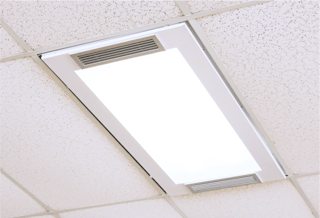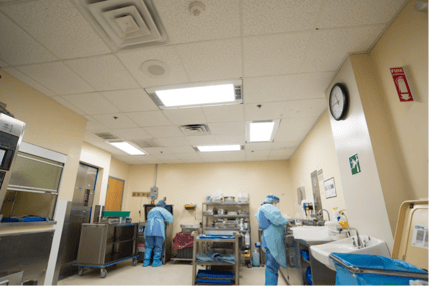According to the latest CDC statistics, hospital acquired infections (HAIs) affect 5 to 10 percent of hospitalized patients in the U.S. per year, with approximately 1.7 million HAIs occurring in U.S. hospitals each year, resulting in 99,000 deaths and an estimated $20 billion in healthcare costs.
These are sobering numbers, and, as anyone working in a healthcare facility setting can attest, HAI’s are a stubbornly persistent challenge. Recent studies show that the airborne dispersion of resistant organisms such as Clostridium Difficile (C. diff) and Methicillin-Resistant Staphylococcus Aureus (MRSA) often play a role in non-respiratory infections. In fact, hospital air samples have been found to be up to 8 times more contaminated than surfaces with MRSA and C. diff.
HAI - Finding a Solution
How can the air be better treated to reduce airborne transmission of these organisms? This question took on personal significance for Mark Welker after his wife Beverly contracted a life-threatening HAI during a hospitalization. As an inventor who holds multiple patents, including those involving lighting and HVAC products, Welker looked around the hospital in search of an answer. He knew that no matter how well staff worked to keep the environment bacteria free, the constant flow of traffic within a hospital, particularly in the patient room, meant that new sources of human bacteria were being introduced, filling the air and settling on surfaces in between cleanings.
He wanted to find a solution that met certain requirements. It needed to be operating continuously and it needed to operate without the need for human involvement to turn it on or off. It also needed to be unobtrusive and easy to install. From his efforts, VidaShield was born.
Hospitals have been using UV-C technology as a disinfection method for decades. The UV-C wavelength of 253.7 nanometers has been proven to be effective at neutralizing dangerous microorganisms, such as C. diff and MRSA. The use of UV-C is limited in the hospital setting since it can’t be used in an occupied space and is only effective on areas that fall in its direct line of sight.
VidaShield offers a shielded UV-C approach that allows for its use in occupied spaces. It combines an ultraviolet germicidal irradiation (UVGI) chamber and air circulating fans with an overhead ceiling light. The patented system uses UV-C light and filtration to draw in and treat environmental air.
It reduces bacterial and fungal populations in treated air and reduces settling bacteria and fungi from treated air 24 hours a day. Installing VidaShield is a simple process, as it fits seamlessly into standard 2x4 drop ceilings. There are several options available for hard ceilings as well.
As part of its continuing effort to offer solutions that can have a positive impact on HAI levels, CME is proud to be the North American distributor for VidaShield.
“HAI’s are a significant concern for our customers,” says KC Meleski, National Sales Manager for CME. “VidaShield offers an effective solution. We especially like the fact that it installs easily and can be placed where it is needed most; directly over the patient bed for example.”
The Benefits of VidaShield
Facilities which have installed VidaShield have seen impressive results. A long-term care facility tested the VidaShield technology in one of three units to determine if the air purification system could have an impact on reducing the LTC-reported infection rates. The VidaShield system reduced airborne bacteria levels by 51%. In addition, the facility reported a reduction in their overall infection rate by 28%.
 An acute care hospital in Massachusetts, after installing VidaShield in their ICU hallways and patient rooms, found airborne bacteria levels in the ICU were reduced 69%, and surface bacteria levels in the ICU were reduced 51%.
An acute care hospital in Massachusetts, after installing VidaShield in their ICU hallways and patient rooms, found airborne bacteria levels in the ICU were reduced 69%, and surface bacteria levels in the ICU were reduced 51%.
To test the effectiveness of VidaShield, a hospital in Nevada installed units in a controlled-access unit within their emergency department that treats homeless, drug-addicted and mentally ill patients. Results of the VidaShield testing showed that airborne bacteria levels were reduced by 80%, and surface levels were reduced by 66%. In addition, hospital nurses and staff reported improvement in air quality and a reduction in odors in the testing area as well as a noticeable improvement in their allergy symptoms.
We’re excited by this new technology and its potential impact on HAI reduction. For further intelligence, read the three case studies provided and this important Peer Review. CME has a complete line of products that will help combat HAI’s. Call CME 800.338.2372 for an account manager that can provide you with information about VidaShield or any of these innovative products.
About CME: CME Corp is the nation’s premier source for healthcare equipment, turnkey logistics, and biomedical services, representing 2 million+ products from more than 2,000 manufacturers.
With two corporate offices and 35+ service centers, our mission is to help healthcare facilities nationwide reduce the cost of the equipment they purchase, make their equipment specification, delivery, installation, and maintenance processes more efficient, and help them seamlessly launch, renovate and expand on schedule.

.jpg)



